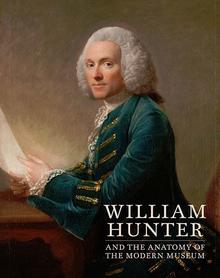“The atmosphere of this cabinet is one of order, neatness and beauty.” That is how Johann Christian Fabricius described the museum of the Scottish physician and obstetrician William Hunter (1718-1783) when he visited it in 1784.[1] The same words might apply to the exhibition of Hunter’s collection, William Hunter and the Anatomy of the Modern Museum, which recently closed at the Yale Center for British Art in New Haven, CT. Having moved there from its opening venue at the University of Glasgow’s Hunterian Art Gallery, the exhibition was exceptionally well-suited to the locations where it was displayed. For above all, this was a show about the eighteenth-century origins and present-day legacies of the public and, in particular, the university museum.
These qualities—of order, neatness, and beauty—were all the more striking given the heterogeneity of objects involved. At Yale, the opening bay contained, among other items: four cone shells from the Madagascan coast; eighty-eight Roman imperial coins; an illuminated manuscript of the Christian Gospels; another of the Quran; an ipu pawehe (decorated water gourd) from the island of Niihau, Hawaii; a glass jar full of dried gallstones; an eleven-thousand-year-old mastodon tusk; a Zebra longwing butterfly; and Jean-Siméon Chardin’s quietly virtuosic painting A Lady Taking Tea (1743) (Fig. 1). The eclecticism of this display was very much the point. Hunter’s collection, which he began to assemble in the mid-eighteenth century and continued to build until his death in 1783, was one of the largest and most comprehensive in Britain. Encyclopedic in scope, it ultimately comprised some 30,000 coins and medals, 10,000 books, 7,500 insect specimens, 6,000 shells, 3,000 anatomical specimens, 1,500 mineral specimens, 650 manuscripts, and 65 paintings, as well as several antiquities, a zoological collection, a large herbarium, and a significant but unknown number of artifacts, primarily from Oceania and the Americas. What might at first glance appear like a random assortment of fine but disparate things was, for Hunter and many of his contemporaries, part of an as yet not fully understood but potentially discernible whole. In elucidating these links, the exhibition sheds new light on the entwined histories of eighteenth-century medicine, art, and science at the same time that it calls attention to some of the dark realities that made this one man’s intellectual pursuits possible.
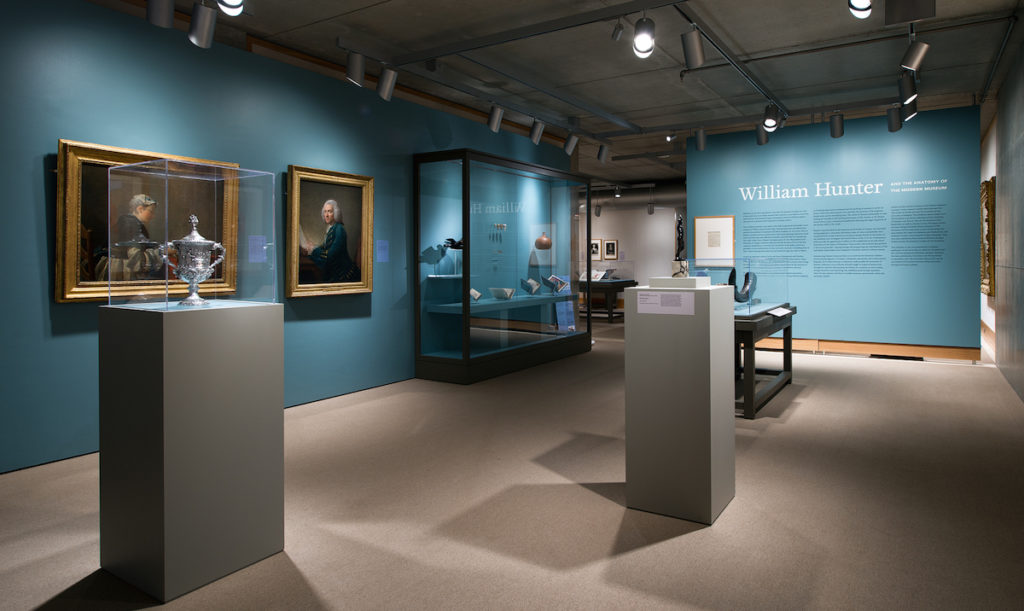
Hunter was born at Long Calderwood, Scotland on May 23, 1718. The son of a farmer of modest means, he nonetheless received an excellent education, first at the local Latin school and then at the University of Glasgow. Though he initially intended to pursue a career in the church, Hunter soon switched to medicine. By the early 1740s, he was in London, where he trained successively with two fellow Scots, the man-midwife William Smellie and the physician and anatomist James Douglas. Over the next decade, Hunter established his own extremely successful practice, eventually following in Douglas’s footsteps to become Physician Extraordinary to the Queen (in which role he delivered all but one of Queen Charlotte’s fifteen children). He also became known as the leading anatomical lecturer of his day, training several generations of medical students from across Britain, the Continent, and North America, and publishing a pioneering work of obstetrical anatomy, The Anatomy of the Human Gravid Uterus Exhibited in Figures (1774). In 1762, at the height of his success, Hunter wrote to the government with a plan to found a national school and museum of anatomy in London. Receiving no reply, he withdrew his proposal three years later and shifted his sights northward. Now, instead of focusing solely on his own specialist fields of anatomy, pathology, and medical history, Hunter began “collecting in the largest sense of the word,” with the intention of one day giving all of it to his alma mater.[2] When The Hunterian Museum at the University of Glasgow finally opened its doors in 1807, it was the first public museum in Scotland and one of the first such institutions in the world.
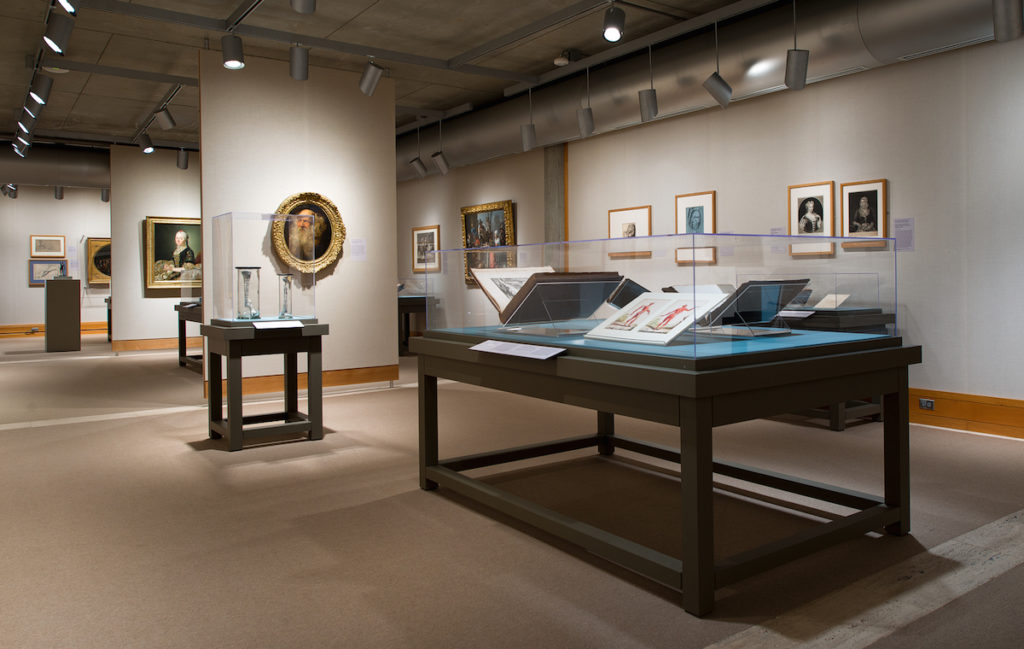
The accompanying publication, co-edited by the exhibition’s joint curators, Mungo Campbell and Nathan Flis, with the assistance of María Dolores Sánchez-Jáuregui, explores this rich history through a combination of thematic essays and detailed catalogue entries.[3] But the material came most alive through its exhibition at the Hunterian and at Yale, where the dense networks of social and physical exchange that shaped Hunter’s life, career, and collections could be traced in their full complexity. Both installations were replete with intricate connections and striking juxtapositions. At Yale, for example, Hunter’s journal of medical attendance on Queen Charlotte was displayed alongside a gold stater of Lachares, an exceedingly rare Athenian coin given to him by the King as a token of thanks for his service. Elsewhere, a mezzotint of Mary Toft of Godalming, “the pretended Rabbit Breeder,” rubbed shoulders with another of Queen Caroline—both women were treated by Hunter’s teacher Douglas (Fig. 2). Further along, in a section on comparative anatomy, a taxidermied horned screamer faced a suite of painstakingly observed and hauntingly poignant portraits by George Stubbs of animals brought to Britain from the far reaches of its empire: a South African zebra, a Canadian bull moose, and an Indian nilgai (Fig. 3). And, in the very last bay, Hunter’s wax-sealed last will and codicil was paired with two impossibly delicate Cuban painted land snails (Polymita picta), which were among the first items to be added to his collection after his death.
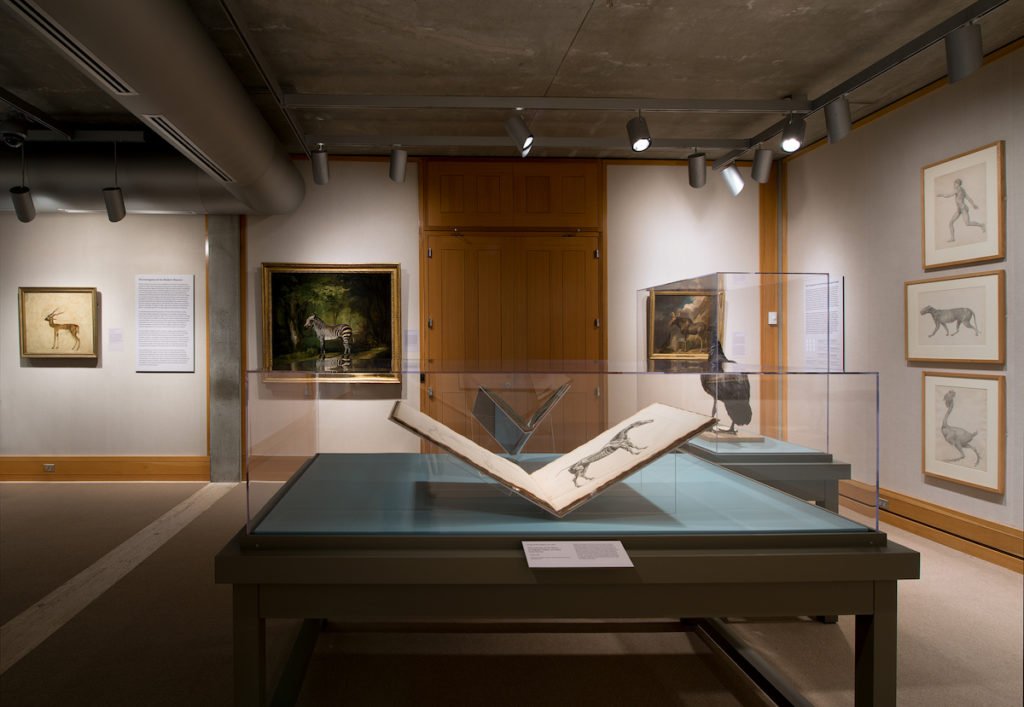
Such an integrative curatorial approach had the distinct advantage of calling attention to Hunter’s collection as a historical entity, one that changed and grew over months and years owing to a variety of circumstances, some planned and others not at all. At the same time, it also restored that collection (which has since been dispersed into multiple departments of the University) to something like its original character. Hunter lived and worked at a moment when many of the disciplines his collections touched on—from entomology and paleontology to anthropology and art history—had barely formed, let alone reached the degree of specialization that would, in subsequent centuries, lead them to be pursued as largely separate and distinct fields of study. For him, the most interesting thing about corals was their “stony” resemblance to fossils and human calculi.[4] Mineral specimens, even the most rare, were to be used for chemical research, even if this meant destroying them in the process.[5] Medieval manuscripts and early modern incunabula, Māori hand tools and Tongan baskets, Japanese Koban and a Chinese woodblock map of the world (made by a Jesuit missionary)—all of these spoke, in their very different ways, to a basic human capacity for invention and expression across time and space (Fig. 4).
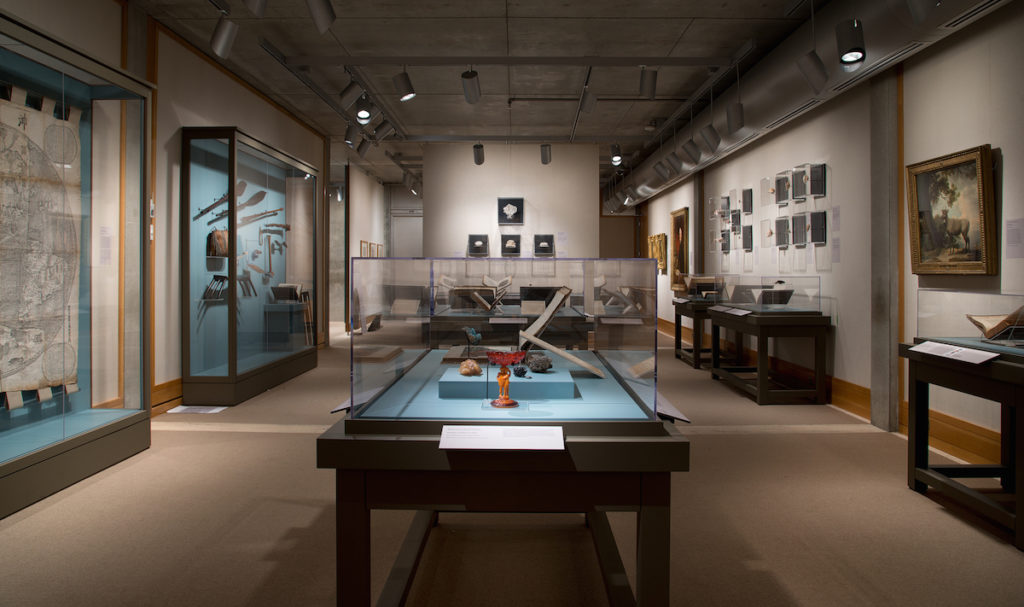
But if connection was one theme running through the exhibition, violence was another—more subtle, perhaps, but no less present. In order to amass his collection, Hunter relied, directly or indirectly, on the extraction of natural resources from the earth; on the uprooting of plants and animals from their environment to be variously examined and dissected, pinned and preserved; on the acquisition of objects from foreign cultures and communities, sometimes through trade and other times by force; and on the procurement of countless dead bodies, often by illegal or illicit means, for his anatomical research and teaching. Possibly because anatomical specimens formed such a large and important part of Hunter’s collection, the curators focused particular attention on this last issue. At Yale, this took the form of a collaboration with four contemporary artists—Selva Aparicio, Claire Barclay, Nate Lewis, and Maya Vivas—who produced works that perform a retrospective “service of gratitude” to Hunter’s anonymous human subjects, in particular the thirteen pregnant women whose corpses he dissected to produce his Gravid Uterus. Especially striking in this regard were a pair of screen prints on vellum by Barclay, Enfolds (I and II), whose soft abstract forms, milky pink tones, and sensual materiality present a powerful counterpoint to the plates of Hunter’s book, which have long been famous for their unsettling combination of vivid beauty and brutal detail (Figs. 5 and 6). It is as if Barclay’s prints restore a measure of humanity and warmth—of wholeness—to the anatomist’s damaged and fragmented subjects.
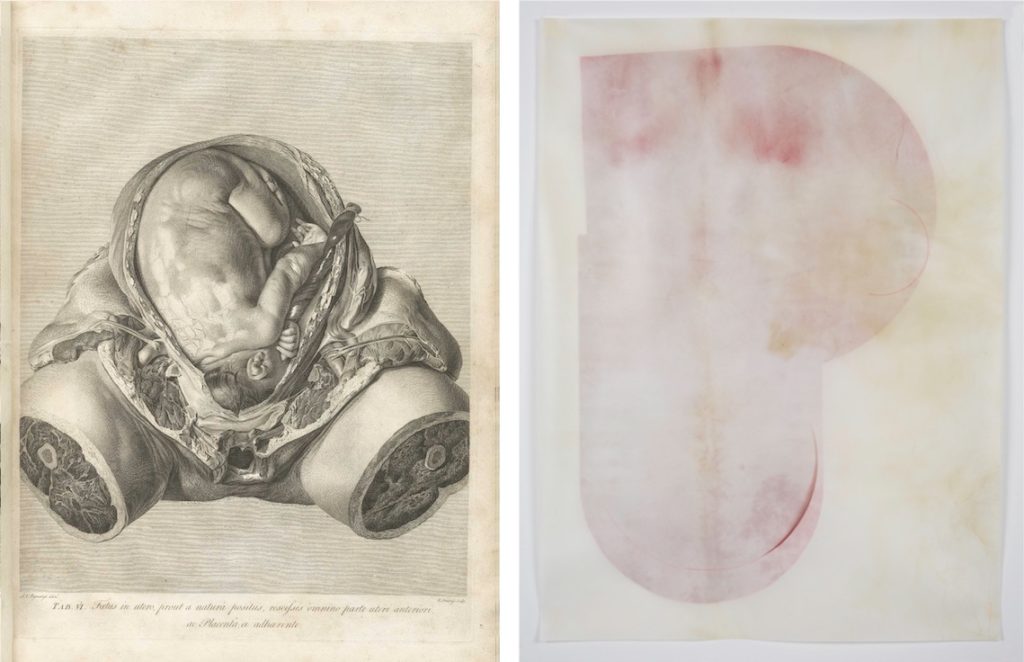
RIGHT: Fig. 6. Claire Barclay, Enfolds (I), 2018. Screen print on vellum, 76 x 56 cm. © Claire Barclay. Courtesy the artist and Stephen Friedman Gallery, London. Commissioned by The Hunterian Museum, University of Glasgow. Photo by Ruth Clark.
One wonders what a similar intervention elsewhere in the exhibition might have looked like: for example, in the large display of so-called “ethnographic objects” that Hunter acquired in the wake of Captain James Cook’s voyages to the Pacific. Perhaps this is something for a future exhibition to do. Given that this one is part of an ongoing series of efforts to reassess and reunite The Hunterian’s cross-disciplinary collection, there will no doubt be more opportunities. Meanwhile, the curators of the present exhibition are to be commended for what they have already accomplished. Far from shying away from the difficult histories that lie at the root of Hunter’s collection, they chose instead to acknowledge and interrogate them. In doing so, they have taken an important step toward making The Hunterian’s collection—and other university collections like it, including Yale’s own—freshly available for both praise and critique.
Meredith Gamer is Assistant Professor in the Department of Art History
and Archaeology at Columbia University in New York, NY
[1] “Der Geist der Ordnung, der Nettigkeit und der Schönheit herrscht in diesem Cabinet.” Johann Christian Fabricius, Briefe aus London vermischten Inhalts (Dessau and Leipzig: Buchhandlung der Gelerhrten, 1784), 94. Quoted in Dominik Hünniger, “‘Extolled by Foreigners:’ William Hunter’s Collection and the Development of Science and Medicine in Eighteenth-Century Europe,” in William Hunter and the Anatomy of the Modern Museum, ed. Mungo Campbell and Nathan Flis (New Haven and London: Yale Center for British Art, New Haven and The Hunterian, University of Glasgow, in association with Yale University Press, 2018), 130. I am grateful to Dominik Hünniger for providing me with this translation.
[2] William Hunter, letter to William Cullen, 1768, in C. Helen Brock, The Correspondence of Dr William Hunter, 1740-1783 (London: Pickering & Chatto, 2008), 1:288, Letter 169.
[3] In the interest of full disclosure, the author would like to acknowledge that she is one of the publication’s contributors. See Meredith Gamer, “Scalpel to Burin: A Material History of William Hunter’s Anatomy of the Human Gravid Uterus,” in Campbell and Flis, William Hunter, 108-125.
[4] María Dolores Sánchez-Jáuregui, “Anatomical Jars and Butterflies: Curating Knowledge in William Hunter’s Museum,” in Campbell and Flis, William Hunter, 170-171.
[5] John Faithfull and Neil Clark, “Ores and Fossils,” in Campbell and Flis, William Hunter, 398-399.
Cite this note as: Meredith Gamer, “Animal, Vegetable, Mineral: William Hunter’s Interconnected Worlds,” Journal18 (July 2019), https://www.journal18.org/3994.
Licence: CC BY-NC
Journal18 is published under a Creative Commons CC BY-NC International 4.0 license. Use of any content published in Journal18 must be for non-commercial purposes and appropriate credit must be given to the author of the content. Details for appropriate citation appear above.

